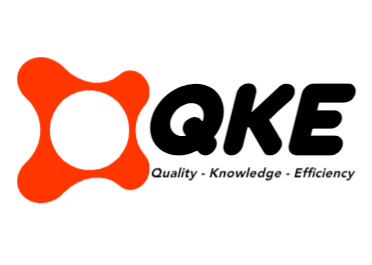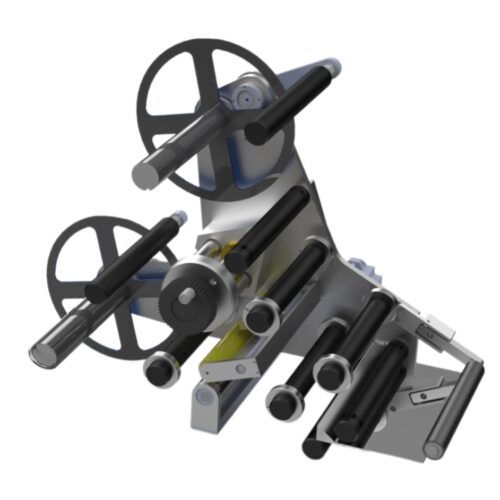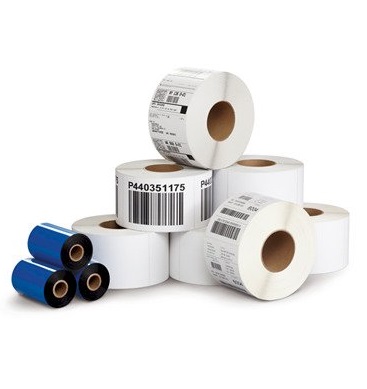Printing accessories streamline labeling and output.
Label dispensers improve throughput and reduce manual handling.
Thermal printing relies on ribbons and labels, with resin options providing enhanced durability. Print and apply software integrates hardware, facilitates data integration, and manages label design.
Rejection devices, incorporating vision systems, maintain quality by detecting defects. Components such as vacuum conveyors, friction feeders, and collection baskets further optimize system performance. Further exploration provides deeper insight.
Label Dispenser
Label dispensers streamline label removal from backing paper, enhancing efficiency in packaging and labeling tasks. These devices cater to diverse operational scales, from small shipping to mass manufacturing. Dispensing preprinted labels by peeling them from their backing, label dispensers come in manual, semi-automatic, and electric variants. Manual models suit lower volume applications, while electric versions are designed for high-speed operations.
Key components include motors (in semi-automatic models), feed-rollers, take-up hubs to manage
liner waste, and peeler plates. Sensory devices like photodetectors guarantee consistent label feeding. The efficient use of
label material is optimized through several advantages:
- Increased throughput by reducing manual handling
- Adjustable settings to fit varied label dimensions
- Stable designs for workbench use
- Hands-free options in semi-automatic models
| Component |
Function |
| Feed Rollers |
Advance label material over peeling edges |
| Take-up Hub |
Collect used liner |
| Peeler Plate |
Separates label from liner |
| Photodetector |
Ensures consistent label feeding |
Ribbon and Labe
Ribbon and label pairings are central to thermal transfer printing, where the selection of ribbon type is critical to the print's performance and longevity. Ribbons are available in wax, wax/resin, and resin formulations, each suited to different applications. Resin ribbons offer the highest print durability, with superior resistance to chemicals and high temperatures. Considerations for choosing ribbon materials include:
- The substrate material.
- The environmental conditions.
- Compliance requirements.
- Desired lifespan of the label.
Thermal transfer labels provide high-resolution prints that are essential for barcode scanning and other exacting applications.
| Ribbon Type |
Material |
Durability |
| Wax |
Wax |
Low |
| Wax/Resin |
Wax and Resin |
Medium |
| Resin |
Resin |
High |
| Eco-Friendly |
Varies |
Varies |
| Specialty |
Varies |
Varies |
Recent trends emphasize sustainable options, with efforts to deliver eco-friendly ribbons and recyclable substrates to reduce environmental impact.
Print and Apply Software
Print and apply software integrates varied hardware components into a unified system for automated labeling applications. This software facilitates data integration, enabling seamless communication between the printing system and host databases for label generation. System compatibility is a crucial aspect, ensuring harmonious operation with existing production lines. Key functions of the software include:
- Label design and template management.
- Variable data handling.
- Real-time error reporting.
- Connectivity options for diverse hardware.
The software streamlines operations by minimizing operator handling, which significantly improves production speed. The software also supports pre-printed label options, adding operational flexibility. Typical data includes the following:
| Feature |
Description |
| Automation |
Reduces manual intervention |
| Error Tracking |
Provides real-time logs and diagnostic summaries |
| Throughput |
Increases production speed |
| Label Variation |
Supports multiple label types |
| System Interface |
PLC connectivity |
Rejection Device
In high-speed printing systems, rejection devices play a vital role in maintaining output quality through the removal of unsatisfactory prints. Vision systems verify print quality, leading to precise rejection. Automated systems ensure that only compliant products reach consumers. Down stackers and accumulators help maximize throughput.
Types of rejection systems vary:
- Soft push
- Multi-finger
- Single-unit
- Integrated third-party
Accurate detection of print defects is key to efficient rejection systems. System integration with quality-control systems enhances accuracy and ensures adherence to compliance standards. Data from the rejection process also provides insights into optimization areas. Rejection systems are often paired with vacuum track conveyors, friction feeders, and accumulation conveyors.
| Component |
Function |
| Vacuum Conveyors |
Smooth transport during verification |
| Friction Feeders |
Precise material supply |
| Collection Baskets |
Efficient collection of rejected products |

 Tiếng Việt
Tiếng Việt


